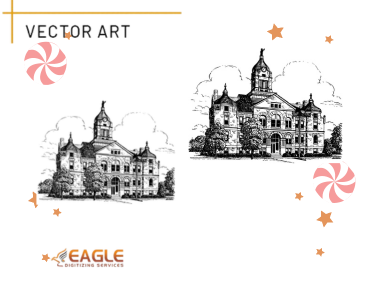Mastering Thick Line Embroidery: Techniques and Tips/Eagle Digitizing
Why do Thick Lines Matter in Embroidery?
Thick lines in embroidery add dimension, boldness, and visual impact to designs. They create outlines, define shapes, and make intricate details stand out, transforming ordinary patterns into striking artworks.
Common Uses for Thick Lines in Embroidery Designs
Thick lines are widely used in various embroidery applications, from logo embroidery on apparel to decorative stitching on home textiles. They enhance visibility, improve readability, and contribute to the overall durability of embroidered pieces.
Understanding Embroidery Basics
Key Terms: Stitches, Density, and Underlay
Stitches refer to the individual movements of the embroidery machine's needle and thread. Density measures how closely stitches are placed together, influencing the solidity and coverage of embroidered areas. Underlay stitches are foundational stitches that provide stability and prevent fabric distortion.
Types of Stitches: Satin, Fill, and Running Stitches
Satin stitches are smooth and shiny, ideal for creating solid lines and smooth curves. Fill stitches cover larger areas with repeated patterns, suitable for filling shapes and creating textured surfaces. Running stitches are basic and linear, used for outlining and finer details.
How Stitch Types Affect Line Thickness
The choice of stitch type directly impacts the thickness and appearance of embroidered lines. Satin stitches produce bold, continuous lines, while fill stitches can create thicker lines by stacking layers of stitches.
Choosing the Right Materials
Best Threads for Thick Lines
Thicker threads like 30-weight or 40-weight polyester or rayon threads are suitable for creating bold lines. Metallic and variegated threads can add texture and visual interest to thick lines.
Needle Selection: What You Need to Know
Use needles with larger eye sizes to accommodate thicker threads. Needles with a sharp point are ideal for piercing through dense fabrics without causing snags or thread breaks.
Suitable Fabrics for Bold Embroidery
Heavyweight fabrics such as denim, canvas, and twill provide a stable base for thick lines. These fabrics can withstand the density of embroidery stitches without puckering or distortion.
Preparing Your Design
Designing with Thick Lines in Mind
Start with clear, bold outlines in your digital artwork to ensure clarity in the final embroidered piece. Simplify complex designs to emphasize thick lines and maintain visibility.
Adjusting Your Artwork for Embroidery
Optimize your designs by adjusting line thickness, reducing unnecessary details, and ensuring scalability for different embroidery sizes.
Using Software to Plan Thick Lines
Software tools like Wilcom, Hatch, and Adobe Illustrator allow you to manipulate line thickness, adjust stitch types, and simulate embroidery outcomes before stitching. This planning phase ensures precision and reduces production errors.
Using Satin Stitches
Why Satin Stitches are Great for Thick Lines
Satin stitches are versatile and create smooth, continuous lines that stand out on fabric. They are ideal for outlining shapes, creating bold text, and adding borders to designs.
Setting Up Satin Stitches in Your Design
Define the width and direction of satin stitches in your embroidery software. Use underlay stitches to stabilize the fabric and ensure even coverage of satin stitches.
Tips for Even and Consistent Satin Stitches
Maintain consistent tension on your machine to prevent loose or puckered satin stitches. Experiment with different stitch lengths and densities to achieve the desired thickness and smoothness.
Working with Fill Stitches
Creating Thick Lines with Fill Stitches
Stack multiple layers of fill stitches to create thicker lines. Adjust the stitch angle and pattern density to enhance coverage and texture.
When to Use Fill Stitches for Bold Lines
Fill stitches are suitable for larger areas where solid coverage and texture are desired. They can create bold outlines for designs that require a more substantial presence.
Techniques for Smooth and Uniform Fill Stitches
Ensure uniformity by digitizing fill patterns with precise stitch angles and densities. Test stitch samples to evaluate the appearance and adjust settings as needed for smoother results.
Layering Techniques
Building Up Thickness with Multiple Layers
Layering involves stacking stitches of the same or different types to create depth and thickness. It enhances visual appeal and can simulate texture in embroidered designs.
Best Practices for Layered Stitches
Start with a solid foundation of underlay stitches to support subsequent layers. Gradually increase stitch density and adjust thread colors to achieve dimensional effects without bulkiness.
Avoiding Bulk and Fabric Distortion
Monitor fabric tension and use appropriate stabilizers to prevent distortion when layering stitches. Choose lightweight stabilizers for intricate designs and heavy stabilizers for dense stitching.
Adjusting Stitch Density
Importance of Stitch Density in Thick Lines
Stitch density determines the solidity and coverage of embroidered lines. Increase density for thicker lines and reduce it for finer details, ensuring balanced stitch formation.
How to Increase Density for Bolder Lines
Adjust stitch parameters in your embroidery software to increase stitch density. Perform test stitches on sample fabrics to gauge the impact on line thickness and fabric texture.
Balancing Density with Fabric Type
Consider the weight and stretch of the fabric when adjusting stitch density. Lightweight fabrics may require higher densities to prevent gaps, while stretch fabrics need lower densities to maintain elasticity.
Using Multiple Stitch Passes
How Multiple Passes Create Thickness
Multiple passes involve stitching over the same area multiple times to build up thread layers and increase line thickness. This technique enhances the visibility and durability of embroidered lines.
Planning Your Design for Multiple Passes
Digitize designs with clear paths for multiple passes to ensure alignment and avoid overlapping or gaps between stitches.
Ensuring Alignment Across Passes
Use registration marks and software tools to align multiple stitch passes accurately. Secure fabric hooping and maintain consistent machine settings for precise stitching alignment.
Combining Stitch Types
Mixing Satin and Fill Stitches for Effect
Combine satin and fill stitches to create contrast and depth in your designs. Use satin stitches for outlines and fill stitches for interior areas to enhance visual interest.
Using Running Stitches for Outlines and Details
Running stitches are perfect for outlining thick lines and adding intricate details to designs. They provide definitions and can be used in conjunction with other stitch types for varied effects.
Creating Depth with Varied Stitch Types
Experiment with different stitch types and combinations to achieve three-dimensional effects. Varied textures and densities add richness and complexity to embroidered lines.
Adjusting Machine Settings
Customizing Your Embroidery Machine Settings
Adjust stitch length, width, tension, and speed settings on your embroidery machine to optimize thick-line embroidery. Refer to machine manuals and test stitches to fine-tune settings.
Stitch Length and Width Adjustments
Increase stitch length and width for thicker lines, ensuring adequate thread coverage without overcrowding stitches. Monitor machine settings during production to maintain consistent results.
Speed Settings for Thick Line Embroidery
Slow down machine speed when stitching thick lines to maintain accuracy and reduce thread tension. Adjust speed settings based on fabric type and design complexity for optimal outcomes.
Stabilizing Your Fabric
Importance of Stabilizers for Thick Lines
Stabilizers support fabric during stitching, preventing stretching, shifting, and distortion. Choose stabilizers based on fabric weight and embroidery technique to ensure smooth, precise stitching.
Choosing the Right Stabilizer for Your Project
Select tear-away, cut-away, or wash-away stabilizers depending on fabric type and design complexity. Hoop stabilizers with fabric securely to maintain tension and stability throughout the embroidery process.
Hooping Techniques to Prevent Shifting
Proper hooping techniques involve stretching fabric taut and evenly within the hoop. Avoid over-tightening to prevent distortion and puckering, ensuring stable stitching for thick lines.
Testing and Tweaking
Running Test Stitches for Thickness
Perform test stitches on sample fabrics using different stitch types, densities, and settings to evaluate line thickness and appearance. Adjust parameters based on test results for optimal outcomes.
Analyzing Test Results for Improvements
Inspect test stitch samples for evenness, coverage, and texture. Note any inconsistencies or issues and make necessary adjustments to digitizing settings or machine parameters.
Making Necessary Adjustments for Perfection
Fine-tune stitch parameters, thread tensions, and stabilizer choices based on test stitch feedback. Repeat testing and adjustments until satisfied with the thickness and quality of embroidered lines.
Troubleshooting Common Issues
Fixing Uneven or Gapped Lines
Address uneven or gapped lines by adjusting stitch density, thread tension, or digitizing settings. Use software tools to redraw lines and optimize stitch paths for smoother results.
Addressing Fabric Puckering
Prevent fabric puckering by using appropriate stabilizers and adjusting hoop tension. Test stitch on scrap fabric to identify potential puckering issues and make preemptive adjustments.
Dealing with Thread Breaks and Snags
Minimize thread breaks and snags by using high-quality threads, adjusting needle size, and ensuring proper thread tension. Clean and maintain your embroidery machine regularly to prevent mechanical issues.
Advanced Techniques
Creating 3D Effects with Thick Lines
Achieve three-dimensional effects by layering stitches, using raised embroidery techniques, or incorporating textured threads. Experiment with light and shadow to enhance depth perception.
Using Specialty Threads for Unique Textures
Explore metallic, variegated, and textured threads to add visual interest and tactile appeal to thick lines. These specialty threads create shimmering effects and enhance embroidery designs.
Incorporating Thick Lines in Complex Designs
Integrate thick lines into intricate designs by balancing line thickness with negative space. Use contrasting colors and stitch densities to highlight focal points and create dynamic compositions.
Software Tips and Tricks
Best Software for Designing Thick Lines
Choose embroidery software like Wilcom or Hatch that offers precise control over stitch types, densities, and line thickness. Use built-in tools to visualize and adjust designs for thick-line embroidery.
Using Software Tools to Adjust Thickness
Utilize editing tools to manipulate line thickness, stitch angles, and underlay settings. Preview designs in 3D simulation to anticipate how thick lines will appear on different fabrics.
Importing and Exporting Designs for Embroidery Machines
Import vector artwork or digitized files into embroidery software for editing and customization. Export finalized designs in compatible file formats (e.g., DST, PES) for seamless transfer to embroidery machines.
Mastering thick-line embroidery involves choosing the right materials, understanding stitch types, adjusting machine settings, and testing designs rigorously for optimal results. Experiment with different techniques, materials, and design concepts to discover your unique style in thick-line embroidery. Embrace challenges and learn from each project to refine your skills.
With dedication and practice, you can master the art of thick-line embroidery. Embrace creativity, seek inspiration from diverse sources, and enjoy the process of transforming designs into captivating embroidered masterpieces.



